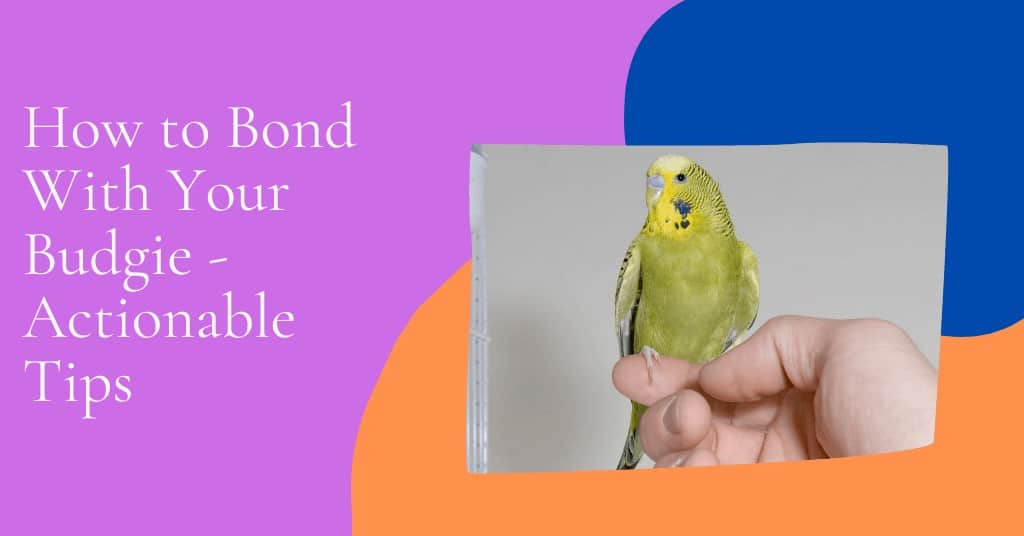Learning how to bond with your budgie isn’t like learning a bike. It’s way easier! In fact, you’ve probably already known how to do it. It’s very similar to bonding with any other type of animals, such as a cat or dog.
Bottom line, Bonding with your budgie requires social interaction and plenty of physical touching. Speaking softly and often to your budgie, holding your budgie, and playing with her will help form a bond. Younger budgies bond easier than adult budgies.
That doesn’t mean your adult feathered friend is out of luck though. With a bit of taming, treats, toys, play, and allowing to perch on your finger, an adult budgie will eventually bond with you just like an adult cat or dog.

Getting started bonding with a new adult budgie
If you’ve got an adult budgie that you wish to bond with, some of these tips will get you started.
Adult birds can be a bit picky when it comes to bonding. The process can be a bit more overwhelming and the training could take a while, but it’s completely doable.
If he’s not yet comfortable with your hand, you may need to help him become comfortable with it. This can be achieved by simply stroking his back and body feathers while he’s on the bottom of the cage, for a few days in a row.
While doing this, you will want to stick your hand right into his cage so that he can learn to trust you. If he’s not yet tame enough, do not force your hand near him as this could cause him harm or fear.
Keep your hand at least two inches away from his body and move it slowly towards him (if he seems scared) until he gets used to it being there.
Don’t shove your fingers in his face, just allow them to hover around every now and then without making contact as long as he’s not scared of your hand.
Once he becomes accustomed to your hand being near him, try to give your budgie a treat or two every time you visit.
This will trigger his positive reward system so that he begins to associate your visits with something positive such as food and/or attention from you.
Make sure that the treats are healthy (sugar-free, fat-free, salt-free) in order to avoid any undesirable results.
Try holding him on your lap and see how he reacts (if he’s comfortable). It won’t hurt to hold him for a few minutes while sitting on the floor.
If he starts biting at you, let go and leave for a bit until it seems like he’s calmed down again before trying to hold him again.
Consider singing to him, or talking with a smooth quiet voice. This will make him more comfortable and teach him he shouldn’t be afraid of you. Remember, birds speak in song and noises.
A human can do this too!
The more you spend time with your feathered friend, the more accustomed and bonded he will become.

Pet bonding a young budgie that hasn’t been hand-fed
Bonding a young budgie is far easier and faster than bonding an older budgie. Once they’re about 5-6 weeks old, you can start taming your feathered friend and introducing her to you by gently handling her.
By simply remaining calm, offering good foods, a lot of touching and handling, a young budgie will quickly accept you into her flock.
A lot of time this will come completely naturally to both you and the bird, but even in this case, there are some things that you can do to help the process along.
With young budgies, it’s crucial that they’re taught what their human is and isn’t.
As a male gets older they may think of you as a mate.
Be sure not to let this phase go on for too long though, because once your bird’s male hormones kick in (usually before adulthood and around 6 months old), it gets weird.
Don’t wait to train, it’ll be like dealing with any other adult bird which requires more time dedicated towards taming and bonding.
The younger the baby budgie is when she comes home with you, the faster she will bond with you.

Bonding a newborn baby budgie or parakeet that’s been hand-fed
Babys this young are very delicate so hand-holding will need to be done gently, and usually only when feeding.
What we used to do, after a feeding, was to allow the baby budgies to curl up under our chin on the neck. It stays nice and warm there and the bonding experience for both the baby and human is immense.
Overall, bonding while hand-feeding a baby budgie is automatic. Not much will need to be done outside of the usual feeding, cleaning, and keeping warm.
Quality time singing and talking will increase the bond and help her feel like she is part of your family.
Spend as much time as you can during this stage. Honestly, you will probably have to anyway, baby birds are quite demanding of your time!

Bonding with a previously abused budgie adult
This one can be very difficult. Just like any abused animal, Fixing the error a previous human has made will be extremely hard.
A whole new world of trust needs to be built from the bottom up, and you will need to undo all the awfulness the bird has been through.
For an abused bird, he will be extremely frightened of your touch. It’s important that you calm down so that he can feel the comfort and safety in your presence.
First thing first:
This can and WILL take a while. You must be patient.
His trusting you again is paramount to his survival as a companion parakeet or budgie. This is all about building trust, not getting him to like you (that comes later).
This is about survival for him – if he doesn’t learn to trust you now, he never will! He needs to heal from his trauma and he needs you to help him do that.
Don’t try to force anything on him, but rather work with what he is giving you and slowly over time earn his trust back. It’ll come eventually! Here are some things we do in any case:
- His cage should be placed in your bedroom, not the living room or any other area. This allows you to bond with him but also keep an eye on his safety and well-being at night.
- Singing, cooking, and talking is crucial while bonding a previously abused budgie! We recommend (if they aren’t adults or will allow it) letting them sleep under your chin during this time so that they can hear you breathe (and hopefully feel comforted).
- Spend as much quality time with him as possible when he feels comfortable enough to let you. Do things outside of the cage together, like watching television and hanging out in your bedroom.
- Allow him to approach on his own terms, with the door open to his cage. When he does approach you, do not touch or try to pick up! Give him his space. He’ll let you know when he’s ready.
Depending on how badly he was abused, you may have bouts of him attacking you for no reason, or flying at your face when you open his door to feed. This is scary and mean but it happens once in a while.
Be patient!
Sometimes, rarely, but sometimes, bonding will be impossible. Just do your best to help him overcome his past trauma, show him that not all humans are monsters.


